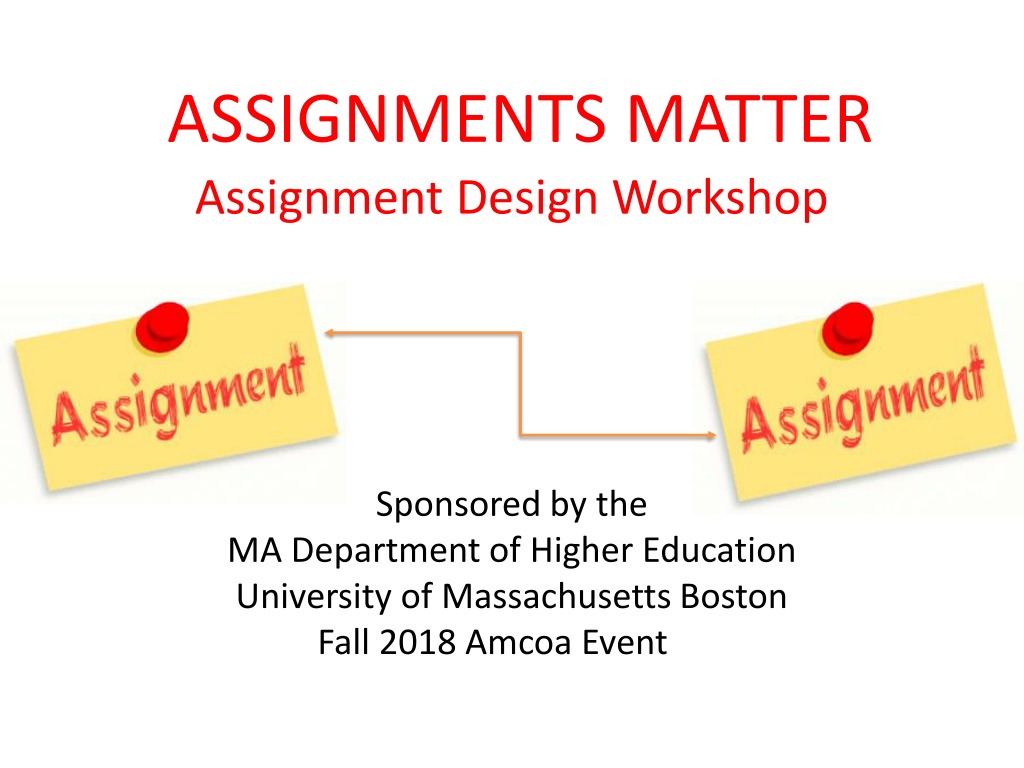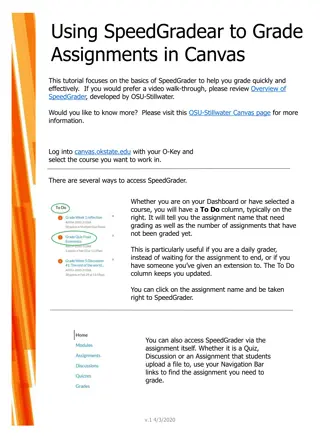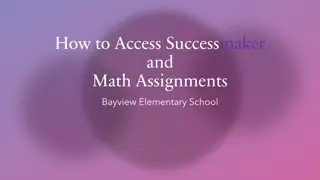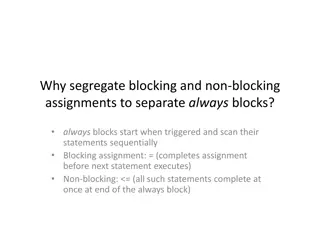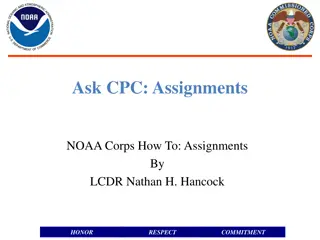ASSIGNMENTS MATTER
Create powerful assignments that put student assessment at the forefront. Focus on intentional design, clear outcomes, and collaboration for improved teaching and learning outcomes. Engage in iterative processes and involve peers, colleagues, and students to optimize assignment effectiveness.
Download Presentation

Please find below an Image/Link to download the presentation.
The content on the website is provided AS IS for your information and personal use only. It may not be sold, licensed, or shared on other websites without obtaining consent from the author.If you encounter any issues during the download, it is possible that the publisher has removed the file from their server.
You are allowed to download the files provided on this website for personal or commercial use, subject to the condition that they are used lawfully. All files are the property of their respective owners.
The content on the website is provided AS IS for your information and personal use only. It may not be sold, licensed, or shared on other websites without obtaining consent from the author.
E N D
Presentation Transcript
ASSIGNMENTS MATTER Assignment Design Workshop Sponsored by the MA Department of Higher Education University of Massachusetts Boston Fall 2018 Amcoa Event
Assignments Matter Assessment of authentic student work puts assignments at the center of student assessment; melds the tension between assessment for accountability and assessment for improvement Focus on assignment design engages us as faculty members in the process of assessment; it puts assessment directly in faculty hands keeping faculty judgment about the quality of student work at the center of the assessment process Assignments are a powerful form of assessment they are integral to the learning process. Assignments are created by faculty and completed by students.
Assignments Matter Focus on assignment design reduces the likelihood of a disconnect between the assignment instructions what the assignment actually prompts students to demonstrate and the learning outcomes the student work will be assessed for. A recognition of the importance of more intentionally designed assignments linked to clear outcomes may have an impact on our course design and pedagogical approach.
ASSIGNMENTS MATTER Assignment design is a powerful occasion for collaboration within and across institutions, creating opportunities for more integrative forms of student learning (as assignments are linked to one another across the curriculum), engaging professional development, and forms of assessment that lead to actual improvements in teaching and learning. Dr. Patricia Hutchings, Senior Scholar, NILOA
ASSIGNMENTS MATTER There is increasing recognition of the importance of assignment design for enhancing student learning and performance, yet it is still often not at the forefront of teaching, learning, and assessment discussions. Too often, assignments exist in isolation of other assignments. They are not sequenced; they are not intentionally designed. Too often, the sum of all the assignments does not add up to something greater than the parts.
ASSIGNMENTS MATTER Assignment Design as a Collaborative and Iterative Process Faculty have found it beneficial to involve peers/colleagues from within and outside of your area of expertise Important to view assignment design as an iterative process Complete the assignment yourself Involve students Annotate assignment in class Share your completed assignment with them Provide a list of sources and evaluate them with students
ASSIGNMENTS MATTER Importance of Mapping Curriculum Map: where in the curriculum are the program outcomes being addressed; where in the curriculum are you measuring performance Mapping of assignments to outcomes not just topics - assignments should be backward designed, that is designed so as to elicit student demonstration of specific learning outcomes Importance of Scaffolding Within assignments Does your assignment scaffold appropriately sequenced instructions, for example, or shorter assignments building up to the final assignment - such as intermediary research paper steps and assignments Within a course Do you have the appropriate degree of scaffolding within your course Across courses within the major or program May involve removing supports as students advance Importance of Linking Assignments Within and Across Courses How do courses and assignments build towards mastery through multiple opportunities to practice repetition, and through increasing expectations raising the bar with respect to demonstrated learning and performance on specific learning outcomes?
ASSIGNMENTS MATTER Inclusive Excellence Inclusive Excellence (AAC&U) calls upon higher education to address the issues of diversity, inclusion, and equity. Transparency TILT Transparency in Learning and Teaching Transparency enhances the success of first-generation, low-income, and underrepresented college students
ASSIGNMENTS MATTER Transparency and Equity Review with students the skills and outcomes they are being asked to demonstrate; explicitly link the assignment to course outcomes. As a class, have students annotate the assignment instructions Review with the student the task the assignment is asking them to undertake. As a class, have students annotate the assignment instructions. What are they being asked to do. What steps might assist them in completing the assignment. What common mistakes or roadblocks do they want to be aware of. Provide clear criteria for success Offer examples of successful work. In class, have students annotate them to identify how the assignment meets the evaluative criteria Transparent assignments enhance equity reduce differences in performance due to differences in educational capital students enter our classroom with give all students a fair chance; do not unduly privilege one group of students over another
ASSIGNMENTS MATTER INCLUSIVE EXCELLENCE Design assignments to assist in achieving an inclusive classroom by addressing issues of diversity Design assignments to represent a diverse set of perspectives Design assignments to assist in linking content to student experiences Design assignments that provide students the opportunity to bring their perspectives into the conversation and to learn from one another. This may be accomplished through the use of in-class or out-of-class study/work groups.
ASSIGNMENTS MATTER Transparency in Learning and Teaching: TILT ASSIGNMENT DESIGN: Assessment approaches assignments - should allow for multiple ways for students to demonstrate mastery, rather than a one-size-fits-all approach. Poorly written and/or ambiguous student learning outcomes make it difficult for students to understand what is expected of them and thus, demonstrate their learning. Instructions for student work should include an appropriate level of scaffolding and should be explicit and detailed containing enough information so that students do not need to read between the lines. Have students been provided with the steps and supports needed to perform successfully and move from one level to another? Is the assignment connected to other assignments? Do not assume that students have entered your course or program with specific skills already developed. Writing, critical thinking, and information literacy skills (just to name a few) may not have been emphasized in the students previous academic experience.
ASSIGNMENTS MATTER Transparency in Learning and Teaching: TILT ASSIGNMENT EVALUATION: CLEARLY DEFINED RUBRICS: o Guide the design of your assignment o Allow students to see exactly what is expected of them o Help instructors evaluate student work consistently across students o Help instructors avoid bias when assessing student work o Help instructors avoid the temptation to compare students against their peers and help ensure instructors evaluate students based upon a pre-determined standard as specified in the rubric Disaggregate assessment data garnered from the evaluation of student work in order to develop interventions to help struggling students. Importance of systematic analysis of student performance on assignments is important. When students do not perform well on assignments, ask them why. It may be that the instructions were not as clear as the instructor thought, or the students did not understand a concept and need review.
ASSIGNMENTS MATTER Characteristics of a Well-Designed Assignment drawn from work by NILOA Peter Ewell (2013) and Pat Hutchins 1. Clarity: Are the assignment instructions clear to students? Are they explicit with respect to what you as the faculty member expect? Do they spell out clearly the purpose of the assignment and the central task the student is being asked to undertake? 2. Intentional Design: Are the assignment instructions clearly linked to the outcome(s) the assignment is designed to accomplish? Does the assignment move students closer to achieving the outcome(s)? How many outcomes can this assignment reasonably address? 3. Communication: Do the assignment instructions clearly address how the required task should be undertaken and how the results should be communicated?
ASSIGNMENTS MATTER Characteristics of a Well-Designed Assignment 4. Evidential: Do the assignment instructions clearly articulate how extensive and evidential the answer should be? How many examples are needed? How many sources are needed? How many pages? 5. Scaffolding: Do the assignment instructions have built in an appropriate degree of scaffolding? Did your classroom work and previous assignments help to prepare the student to successfully complete the assignment? 6. Evaluation: Are the assignment instructions explicit with respect to how the resulting student work will be evaluated? Do you have a rubric to accompany the assignment instructions for evaluation purposes?
ASSIGNMENTS MATTER Characteristics of a Well-Designed Assignment OTHER CHARACTERISTICS? YOUR THOUGHTS?
ASSIGNMENTS MATTER PAIR WITH A PARTNER SOMEONE OUTSIDE OF YOUR DISCIPLINARY AREA 1. Introduce your assignment to your partner - provide information highlighted at the top of the assignment evaluation matrix. 2. Read your partner s assignment -- try to maintain a student perspective 3. Using the evaluation matrix, evaluate your partner s assignment 4. Discuss and give feedback to your partner on the assignment outcomes 5. Discuss and give feedback on the assignment instructions (transparency, equity, inclusiveness, diversity) GENERAL DISCUSSION QUESTIONS WHAT SURPRISED YOU AS A RESULT OF THE ACTIVITY? WHAT WAS MOST HELPFUL? WHAT IS SOMETHING YOU LEARNED THAT YOU CAN SHARE WITH A COLLEAGUE?
RESOURCES 1. NILOA Assignment Library https://www.assignmentlibrary.org/ 2. TILT: Transparency in Teaching and Learning Project https://www.unlv.edu/provost/teachingandlearning https://www.unlv.edu/provost/transparency/tilt-higher-ed- examples-and-resources https://tilthighered.com/ 3. Aligning Educational Outcomes and Practices, Pat Hutchings http://learningoutcomesassessment.org/documents/Occasional%2 0Paper%2026.pdf 4. Catalyzing Assignment Design Activity on Your Campus: Lessons from NILOA s Assignment Library Initiative Pat Hutchings, Natasha A. Jankowski, & Peter T. Ewell http://www.learningoutcomesassessment.org/documents/ Assignment_report_Nov.pdf
